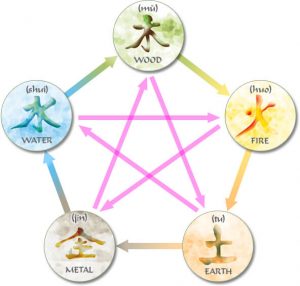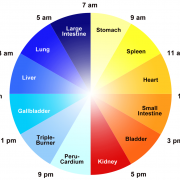The Five Element Theory of Traditional Chinese Medicine
 Traditional Chinese medicine was based on an observation of man in his environment. In early times Chinese doctors identified patterns of continuous change and transformation in the universe and how these changes also occurred within the human body. The concept of qi , the vital energy of the body and the yin yang theory, which views the relationships between things as complementary to the whole, are integral to the master blueprint of the Five Element Theory. This blueprint organizes all natural phenomena into five master groups or patterns in nature.
Traditional Chinese medicine was based on an observation of man in his environment. In early times Chinese doctors identified patterns of continuous change and transformation in the universe and how these changes also occurred within the human body. The concept of qi , the vital energy of the body and the yin yang theory, which views the relationships between things as complementary to the whole, are integral to the master blueprint of the Five Element Theory. This blueprint organizes all natural phenomena into five master groups or patterns in nature.
The five groups include: Wood, Fire, Earth, Metal, and Water. Each of these elements includes many “ categories such as a season, a direction, climate, stage of growth and development, internal organ, body tissue, emotion, aspect of the soul, taste, color, sound …” the list is seemingly endless. This theory gives a template to show “how nature interacts with the body and how the different dimensions of our being impact each other.” It gives a multidimensional view and provides a diagnostic framework to identify where imbalances lie.
We are in the season of spring which is the Wood Element
- The Liver and Gallbladder are associated organs
- Eyes and tendons are associated body parts
- The emotion of anger
- The color green
- Wind
- Calling sound
- Sour taste
- East is the direction
- 11pm-3am time
When the Wood chi is weak indecision and a feeling of being stuck can occur. People who have a strong wood energy have clear goals and vision and are able to manifest their goals. Planning and decision making are their forte.
The Five Element Theory presents a blueprint which organizes all natural phenomena into five master groups or patterns in nature. This theory attempts to show the interaction of nature with the human body and how the many facets of our being impact each other. The Five Element Theory provides us with a diagnostic tool to help identify where imbalances lie and illuminates the interconnectedness of all things. The structures in our body are connected to each other, to our environment and to the natural world. It represents man as part of nature and nature as part of the cosmos.
The Elements are: Wood, Fire, Earth, Metal and Water. We’ve already spoken about the Wood Element of spring and its many associations. Today I want to discuss the Fire Element.
The Fire Element is the next phase of the Five Element theory. Its associations are:
- Heart and Small Intestine Meridians & Pericardium and Triple Warmer Meridians
- Blood vessels
- The tongue
- Joy
- Summer
- The color red
- Bitter taste
- Heat
- Laughing
- Direction –south
- Most active 11am-3pm
People with strong fire energy excel at communication and socialization. They can be charismatic and inspirational speakers. If the Fire Element is weak anxiety, restlessness and insomnia may occur. Stuttering, nervous laugh and rapid speech patterns may develop.
Some illnesses associated with this element are: hypertension, palpitations, heart problems and mouth and tongue sores. Walking is beneficial and the bitter flavor of dark green leafy vegetables. People with weak fire energy can be susceptible to heat exhaustion.










